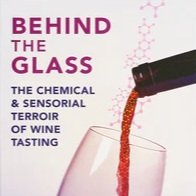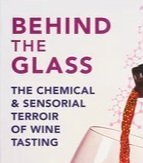'Behind the Glass' - Gus Zhu, MW
‘Behind the Glass’
The Chemical and Sensorial Terroir of Wine Tasting
By: Gus Zhu MW
Behind the Glass looks into the science of what we see, experience in our mouths and smell when we taste wine.
In Behind the Glass readers will discover the science involved in wine tasting and learn why wine tastes the way it does. Wine is chemically extremely complex, while sensory appreciation can be subjective, meaning that our perception of wine is many layered. Behind the Glass is aimed at the non-scientist curious wine lover or wine professional and uses flavour chemistry and sensory science to help readers understand what is going on when they taste a glass of wine. The book is divided into three sections, on the visual appreciation of wine, the taste of wine on the palate and the smell of wine, and explains the chemical and sensory aspects of each. The text is illuminated by accompanying colour illustrations. Behind the Glass concludes with six pairs of wines to taste, to allow readers to put into practice the ideas explored in the book. By understanding more fully the chemical and sensorial aspects of wine tasting readers will equip themselves to better appreciate each glass of wine they taste.
· No science background required: unravels the science behind wine tasting in a way that can be easily understood by anybody with a serious interest in wine.
· Wine colour demystified: explains the chemicals that make up the colours of red, rosé and white wines and how our eyes perceive those colours.
· The chemistry of taste: what are the compounds in wine that make them taste the way they do; from sweet and umami to bitter, sour and even salty how do our tongues taste wine?
· The infinite world of aromas: the chemistry behind the myriad perceptions of wine on the nose and why so much of what we ‘taste’ in wine is actually down to what we smell.
· The science of difference: from genetic variations to individual experiences and preconceptions, why do two people rarely experience the exact same sensations when tasting a glass of wine?
‘Behind the Glass’
The Chemical and Sensorial Terroir of Wine Tasting
By: Gus Zhu MW
Behind the Glass looks into the science of what we see, experience in our mouths and smell when we taste wine.
In Behind the Glass readers will discover the science involved in wine tasting and learn why wine tastes the way it does. Wine is chemically extremely complex, while sensory appreciation can be subjective, meaning that our perception of wine is many layered. Behind the Glass is aimed at the non-scientist curious wine lover or wine professional and uses flavour chemistry and sensory science to help readers understand what is going on when they taste a glass of wine. The book is divided into three sections, on the visual appreciation of wine, the taste of wine on the palate and the smell of wine, and explains the chemical and sensory aspects of each. The text is illuminated by accompanying colour illustrations. Behind the Glass concludes with six pairs of wines to taste, to allow readers to put into practice the ideas explored in the book. By understanding more fully the chemical and sensorial aspects of wine tasting readers will equip themselves to better appreciate each glass of wine they taste.
· No science background required: unravels the science behind wine tasting in a way that can be easily understood by anybody with a serious interest in wine.
· Wine colour demystified: explains the chemicals that make up the colours of red, rosé and white wines and how our eyes perceive those colours.
· The chemistry of taste: what are the compounds in wine that make them taste the way they do; from sweet and umami to bitter, sour and even salty how do our tongues taste wine?
· The infinite world of aromas: the chemistry behind the myriad perceptions of wine on the nose and why so much of what we ‘taste’ in wine is actually down to what we smell.
· The science of difference: from genetic variations to individual experiences and preconceptions, why do two people rarely experience the exact same sensations when tasting a glass of wine?
‘Behind the Glass’
The Chemical and Sensorial Terroir of Wine Tasting
By: Gus Zhu MW
Behind the Glass looks into the science of what we see, experience in our mouths and smell when we taste wine.
In Behind the Glass readers will discover the science involved in wine tasting and learn why wine tastes the way it does. Wine is chemically extremely complex, while sensory appreciation can be subjective, meaning that our perception of wine is many layered. Behind the Glass is aimed at the non-scientist curious wine lover or wine professional and uses flavour chemistry and sensory science to help readers understand what is going on when they taste a glass of wine. The book is divided into three sections, on the visual appreciation of wine, the taste of wine on the palate and the smell of wine, and explains the chemical and sensory aspects of each. The text is illuminated by accompanying colour illustrations. Behind the Glass concludes with six pairs of wines to taste, to allow readers to put into practice the ideas explored in the book. By understanding more fully the chemical and sensorial aspects of wine tasting readers will equip themselves to better appreciate each glass of wine they taste.
· No science background required: unravels the science behind wine tasting in a way that can be easily understood by anybody with a serious interest in wine.
· Wine colour demystified: explains the chemicals that make up the colours of red, rosé and white wines and how our eyes perceive those colours.
· The chemistry of taste: what are the compounds in wine that make them taste the way they do; from sweet and umami to bitter, sour and even salty how do our tongues taste wine?
· The infinite world of aromas: the chemistry behind the myriad perceptions of wine on the nose and why so much of what we ‘taste’ in wine is actually down to what we smell.
· The science of difference: from genetic variations to individual experiences and preconceptions, why do two people rarely experience the exact same sensations when tasting a glass of wine?


